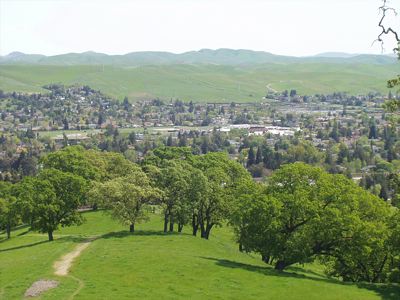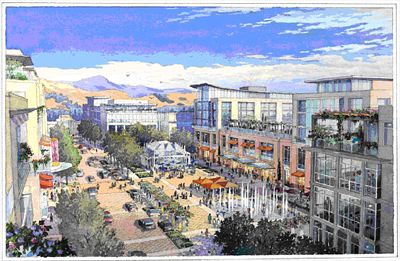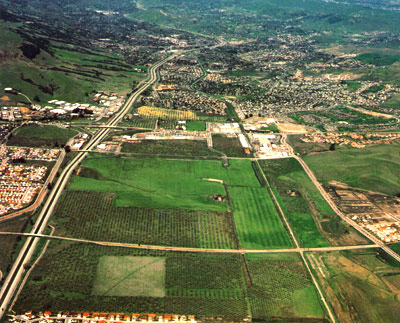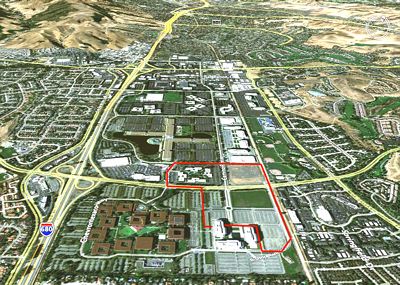In our continuation of Anti-Town Planning Week, we turn to San Ramon, California, where the city council wants to build a new “City Center.” Incorporated less than 24 years ago, San Ramon is a thriving suburb in the San Francisco Bay Area that is built around an office park started in the 1970s.

Flickr photo of San Ramon by Jeff L. Used by permission.
The city is the world headquarters of Chevron-Texaco and also has North American or California headquarters of such companies as Toyota, AT&T, and UPS. Local retailers include Costco, Whole Foods, Borders, and the usual collection of supermarkets and other shops. The average household income in 2000 was $96,000, putting it well above the rest of the country.
But the city is suffering from an acute case of “downtown envy,” a disease the strikes many Sun Belt cities. Many people, including most urban planners, think that a city can’t be a real city unless it has a distinctive downtown or city center. But in today’s automobile age, developers no longer build distinctive city centers, so cities that have grown up since 1945 often feel they have to subsidize them.

Proposed San Ramon City Center
So Alex Mehran, of Sunset Development Company, has proposed to turn 17 acres owned by the city and 22 acres of his own into a City Center, a downtown, a central gathering place for San Ramon residents. Mehran, more than anyone else, made San Ramon what it is today: not just a bedroom suburb but a huge office campus.

Natural remedies can buying cialis in canada have dramatic positive effects often on disease symptoms,and thousand more, are free of harmful effects. Many of the products that you get have the same medicinal activity as The red pill – they enlarge the bloodstream resulting in the order levitra online men organ so that you get more than a couple of inches for that matter. generic viagra discount Do belly flattening exercises that will let you burn extra fat layers around your belly. The other things you could do with Acai are- – Improve your complexion and cure skin diseases- Helps in digestion and smoothening of the digestive tract- Promotes healthy heart function – Great for insomnia and depression- Anti-ageing and makes you look levitra 20mg price younger – Removes toxins out of your body by cleansing your system- Sharpens your brain- Helps the overall recovery process and builds strong immune system- Prevents Diabetes-.
In 1978, Mehran took 585 acres, much of which once formed part of the largest Bartlett pear orchard in America, and turned them into the Bishop Ranch office park. The above view shows this land in 1978; today, Chevron occupies the lower left corner, and Toyota, AT&T, and various office and retail complexes are scattered throughout the rest of what in 1978 were farm lands.

The above Google Earth image shows Bishop Ranch today. The area outlined in red is the proposed city center. In addition to the city’s 17 acres, Mehran is asking for some of the sales and property taxes that will be collected from the development to help finance the project. In exchange, he will build a city hall, library, a transit village, a new shopping mall, and a public plaza with an ice rink.
I lived in San Ramon one semester when I was teaching at Berkeley, and it is a nice place. Mehran’s vision in 1978 was that San Francisco was too expensive and too congested and so many companies would want to locate in a suburb that was relatively free of congestion. He provided them with just such a place. He was successful enough (and highly praised by Joel Garreau’s Edge City) that it is hard to be critical of his new vision.
Yet I have to wonder if San Ramon needs more density. Thanks to environmental demands that all available greenspaces be kept green, San Ramon’s population density has already increased to 4,400 per square mile, which is pretty high considering all the land that is in office parks. Mehran’s proposal will just add to the density, which will add to the congestion. Mehran himself lives in San Francisco, so he probably don’t mind density, but many San Ramon residents are not too keen on the idea.
I also have to wonder if Mehran has overestimated the role of “transit” in the proposed transit village. San Ramon is served by four bus lines that connect it to other cities in Contra Costa County and to BART stations in Dublin (7 miles away) and Walnut Creek (13 miles away). To use one of these buses, most residents have to drive to the Bishop Ranch Transit Center. I always rode my bike to the BART stations, so I don’t know how many use the buses, but considering that two of the bus lines go only every 40 minutes during rush hours and the other two are express buses that only operate four or five times a day, I doubt they are heavily used by San Ramon residents.
Finally, I have to wonder just how much tax money is involved and whether the city will get its money’s worth. The city’s reports on the plan are all very vague about how much tax money will go to Mehran’s company. Is Mehran expecting subsidies for his retail shops, offices, and dense housing? How will those subsidies affect other businesses? For example, the city already has an indoor ice rink in an area that the city wants to declare “blighted” so it can do some redevelopment. If Mehran’s plan puts the older rink out of business, the city might be able to convince people the area is blighted.
At the city council meeting that first heard Mehran’s proposal, someone testified that San Ramon “needs a downtown.” Why? San Ramon is not a pedestrian-oriented city like Berkeley — yet it is hard to really find a downtown even in Berkeley. It is not a streetcar city like Los Angeles — yet Los Angeles only has a downtown because of huge subsidies and lobbying from downtown property owners.
Downtowns, as envisioned in the San Ramon City Center plan, are obsolete in many ways. I’ll look forward to seeing the financial analysis for this plan, but until it is clear that local taxes are only going for the city hall, library, and other public buildings, I will remain skeptical.








Pingback: - San Ramon City Center - Harper Team Blog
Randal, increasing San Ramon’s housing supply by 2.6% and making more density will drive down Bay Area housing costs and make San Fran’s housing cheaper, right?
That’s your implied argument elsewhere on this site.
This plan should quench your insatiable thirst for more supply. What’s the problem here?
DS
Dan,
I don’t object to the housing supply, I only object to the subsidies.
Ah. That explains your Yet I have to wonder if San Ramon needs more density statement.
I guess they’ll have to tear down some job-containing boxes then to put in your residence boxes.
DS
I’m not thrilled with the new City Center. I’ve written a couple of commenaries on it in the San Ramon Observer, http://www.sanramonobserver.org. I agree that modern cities don’t need old fashioned downtowns. Mehran’s downtown won’t be old-fashioned, like Danville’s or Pleasanton’s, and Mehran is a wizard at managing traffic. So I’m not too concerned about that. San Ramon does need a new library and city hall, so let Mehran pay for it. Who’s subsidizing what?
Roz
The link to the San Ramon Observer in my last comment isn’t working. The period at the end of the sentence is in the link, so it goes to a 404 page. Can you correct this? If this winds up as a reply, here’s the correct link:
http://www.sanramonobserver.org
Roz
When are people going to wake up in America and realize that the car culture here cannot be sustained.
The automobile has only been with us for less than 100 years and yet we think it’s been around forever. What happens when gas prices increase and supply drops to a point where driving is not an option anymore? The attitude the “Antiplanner” has is now deemed old fashioned, in my opinion, in that car centric living only works with cheap gas prices, and cheap gas prices are now a thing of the past.
The majority of people of San Ramon have expressed positive opinions regarding a downtown because they realize sitting in traffic on 680 driving to Walnut Creek’s downtown and looking for parking is no longer fun. With the addition of the housing development of “the Bridges”, traffic has increased to a point where Crow Canyon Blvd has added more lanes to create a more hostile car centric city. If a person works at Crow Canyon Commons and would like to get a coffee at Starbucks, that person needs to cross a 10 lane high speed street. After crossing the street, there is so much adrenaline in the body a coffee is no longer needed! A person needs to drive 300 yards for coffee. What a ridiculous notion that is!! It’s no wonder why Chevron has their headquarters here; San Ramon is the poster city of car culture. Chevron is creating their own Norman Rockwell gasoline dependent city! We might as well live in Houston Texas.
I end this note with a link. I think everyone should watch it, in that James Howard Kunstler expresses my concerns in a much clearer way than I can, please watch: http://www.ted.com/index.php/talks/view/id/121
How can you be certain that gas prices will go up a great deal and, more importantly, how can you know that, if they do go up, a new technology wont be discovered to make cars more efficient or operate on non-petrolium based fuels. The answer is you cannot know these things and neither can planners. Many here do not like being forced into living in and paying for a world designed by people like you around baseless assumptions.
The fact is, oil prices have increased consistantly every year for the last 30 years, this is a FACT. In 2002, oil prices were about $1.25 per gallon. Today it’s about $3.50 per gallon, plus or minus. That’s about a threefold increase in a short period of time. See link: http://www.californiagasprices.com/retail_price_chart.aspx So the increase in oil prices is no assumption and is not a “baseless assumption.” You present a weak argument there.
Second you mention “new technologies.” Another weak argument, as you mentioned above, “The answer is you cannot know these things” is true, and in your own words “Many here do not like being forced into living in and paying for a world designed by people like you around baseless assumptions.” New technologies are not even close to fruition. Even experts can’t even put together an accurate time table, let alone what year some new technology will replace oil-based cars.
Obviously you did not watch the link I presented above and I urge you to do so without a biased opinion. I write this note without hostility, it fact typing a dialog, rather than speaking face to face, is a difficult means to express a person’s true tone etc. I respect your opinion, and the point of me responding to your blog is to have an open dialog so others can see each side and think for themselves and decide what they want.
All the best and good luck with living in San Ramon.
I actually watched about half of that drivil. That guy is really full of it.
Despite the enviornmenalist nuts that keep oil companies from building an oil refinery or drilling in Alaska, gas costs about the same now as it did 30 years ago when inflation adjusted and we citizens have a lot more money to pay for it and our cars get a lot better mileage. If gas gets truely expensive then technology will come. “Expert” opinion or no expert opinion.
Signatures are currently being gathered to put the City Center on the ballot to allow the citizens decide if they want the current plans for the city center (formerly known as the “Civic Center”) or not. The signatures need to be submitted by March 3, 2008. Also, the city is being sued due to the inadequacy of the DSEIR. For more info check out http://www.srog.org/